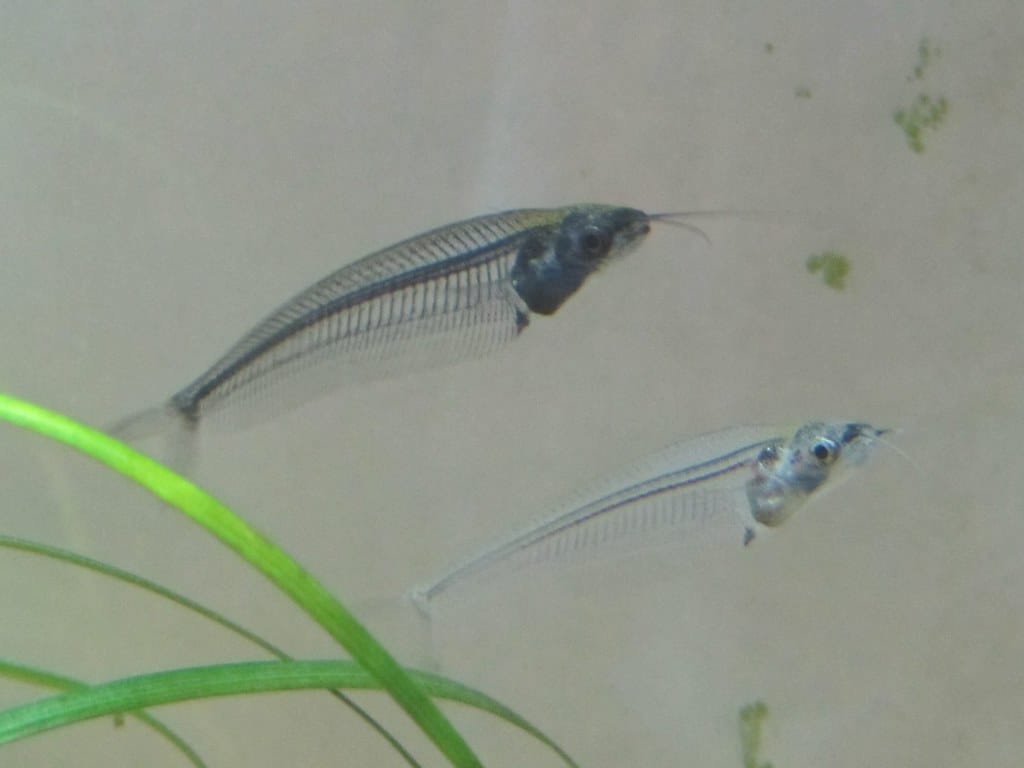Glass Catfish, scientifically known as Kryptopterus vitreolus, are a fascinating and unique species of freshwater fish known for their transparent bodies. These fish are a favorite among aquarists due to their striking appearance and peaceful nature. This comprehensive guide will explore everything you need to know about Glass Catfish, from their natural habitat and physical characteristics to their care requirements, feeding habits, and breeding practices. Whether you are a novice or an experienced aquarist, this article will provide valuable insights into the world of Glass Catfish.
What is an African Glass Catfish?
African Glass Catfish, scientifically known as Parailia pellucida, are a species of transparent catfish native to the freshwater rivers and streams of Africa. These fish are celebrated for their glass-like bodies, which allow their internal organs and spine to be visible. This unique trait makes them a popular choice among aquarists seeking a distinctive and visually appealing fish for their tanks.
Introduction to Glass Catfish
What is a Glass Catfish?
Glass Catfish, often referred to as Ghost Catfish or Phantom Catfish, belong to the Siluridae family. They are native to Southeast Asia, particularly Thailand, Malaysia, and Indonesia. These fish are named for their translucent bodies, which allow their internal organs and spine to be visible, creating a mesmerizing effect in the aquarium.
Natural Habitat and Distribution
Geographic Range
Glass Catfish are primarily found in the slow-moving rivers, streams, and floodplains of Southeast Asia. They prefer shaded areas with dense vegetation and submerged roots, which provide cover and food sources.
Environmental Conditions
In the wild, Glass Catfish thrive in waters with temperatures ranging from 75°F to 80°F (24°C to 27°C) and a pH of 6.5 to 7.5. These conditions provide the ideal environment for the fish to exhibit natural behaviors and maintain their health.

Physical Characteristics
Appearance
Glass Catfish are distinguished by their transparent bodies, which allow their internal structures to be seen. Their slender, elongated bodies are typically 4 to 6 inches (10 to 15 cm) long, with two long barbels that help them navigate and locate food.
Size
Glass Catfish can grow up to 6 inches (15 cm) in length when fully mature. Their transparency and unique appearance make them a captivating addition to any aquarium.
Lifespan
With proper care, Glass Catfish can live for 7 to 8 years in captivity. Providing a stable environment and a balanced diet is essential for ensuring their longevity.
Aquarium Care
Tank Setup
Creating a suitable environment for Glass Catfish involves replicating their natural habitat as closely as possible.
Tank Size
A minimum tank size of 30 gallons is recommended for a school of Glass Catfish. They are schooling fish and require plenty of space to swim together. Larger tanks are preferable, especially if you plan to keep a larger school or add other tank mates.
Substrate and Decor
A soft, sandy substrate is ideal for Glass Catfish, as it mimics the riverbeds they inhabit in the wild. Providing plenty of plant cover is crucial, as these fish enjoy hiding among the vegetation. Use live or artificial plants to create a densely planted environment. Adding driftwood and rocks can also provide additional hiding spots and enhance the natural feel of the tank.
Water Parameters
Maintaining stable water conditions is vital for the health of Glass Catfish. The recommended water parameters are:
- Temperature: 75°F to 80°F (24°C to 27°C)
- pH: 6.5 to 7.5
- Hardness: 5 to 15 dGH
Regular water changes and monitoring of water quality are essential to prevent the buildup of harmful substances.
Filtration and Aeration
Glass Catfish prefer clean, well-oxygenated water. Using a high-quality filter is essential to maintain water quality. Canister filters or powerful hang-on-back filters are ideal for larger tanks. Ensure proper aeration by using air stones or an air pump to maintain high oxygen levels in the tank.
Lighting
These fish are accustomed to shaded environments in the wild, so moderate to subdued lighting is ideal. Too much light can stress them and cause them to lose their vibrant coloration. Floating plants can help diffuse the light and create a more comfortable environment.
Feeding Habits
Diet
Glass Catfish are omnivorous, and in the wild, they feed on small invertebrates, insect larvae, and plant matter. In captivity, it’s important to provide a balanced diet that includes both animal and plant matter.
What Do Glass Catfish Eat?
Offer a variety of high-quality flake or pellet foods formulated for omnivorous fish. Supplement their diet with live or frozen foods such as bloodworms, brine shrimp, daphnia, and tubifex worms. These foods mimic their natural diet and provide essential nutrients.
Feeding Schedule
Feed Glass Catfish small amounts two to three times a day, ensuring that all the fish in the school get their share. Be mindful not to overfeed, as excess food can pollute the water and lead to health issues.
Behavior and Compatibility
Are Glass Catfish Aggressive?
Glass Catfish are peaceful and can coexist with a variety of other fish species. Ideal tank mates include other peaceful community fish that are similar in size and temperament. Suitable companions are tetras, rasboras, guppies, and small gouramis. Avoid keeping them with larger, aggressive species that may bully or prey on them.
Schooling Behavior
Glass Catfish are schooling fish and should be kept in groups of at least five to six individuals. Keeping them in a school helps reduce stress, encourages natural behaviors, and enhances their overall well-being. A larger school can create a more dynamic and visually appealing display in your aquarium.
Breeding Glass Catfish
Breeding Behavior
Breeding Glass Catfish in captivity can be challenging, but it is possible with the right conditions. They are egg scatterers and exhibit interesting breeding behaviors when ready to spawn. To encourage breeding, it’s important to provide optimal water conditions and a suitable breeding environment.
Breeding Setup
To set up a breeding tank, use a separate aquarium with similar water parameters to the main tank. The breeding tank should be densely planted to provide cover for the eggs and fry. A temperature around 78°F (26°C) and a slightly acidic pH of 6.5 to 7.0 are ideal for triggering spawning.
Spawning Process
During the breeding process, the male Glass Catfish will chase the female and nudge her to encourage egg-laying. The female scatters her eggs among the plants, and the male fertilizes them externally. After spawning, it’s important to remove the adult fish to prevent them from eating the eggs.
Raising Fry
The eggs typically hatch within 3 to 4 days, and the fry become free-swimming a few days later. Start feeding the fry with infusoria or commercially prepared liquid fry food. As they grow, you can introduce finely crushed flake food and baby brine shrimp. Regular water changes and maintaining excellent water quality are crucial for the healthy development of the fry.
Health and Disease
Common Diseases
Glass Catfish are generally hardy, but they can be susceptible to common freshwater fish diseases. Some of the most common issues include:
- Ich (White Spot Disease): Characterized by white spots on the body and fins. It can be treated with commercial ich treatments and by raising the water temperature.
- Fin Rot: Caused by bacterial infections, leading to frayed and discolored fins. Improving water quality and using antibacterial treatments can help.
- Fungal Infections: Often appear as white, cottony growths on the body or fins. These can be treated with antifungal medications and by maintaining clean water conditions.
Preventative Measures
Maintaining excellent water quality and providing a stress-free environment are the best ways to prevent diseases. Regular water changes, proper filtration, and avoiding overcrowding are essential. Quarantining new fish before adding them to the main tank can also help prevent the introduction of diseases.
Interesting Facts
Unique Adaptations
Glass Catfish have several unique adaptations that help them thrive in their natural habitat. Their transparent bodies provide camouflage against predators, and their long barbels help them navigate and locate food in murky waters.
Communication
While not vocal, Glass Catfish use body language to communicate with each other. They may engage in fin displays, chasing, and other behaviors to establish social hierarchies and territory within the school.
Nocturnal Activity
Glass Catfish are primarily active during the day but can also exhibit nocturnal behaviors. Providing a consistent light cycle in your aquarium can help regulate their activity patterns and reduce stress.
Why Are Glass Catfish Transparent?
The transparency of African Glass Catfish is a unique adaptation that provides camouflage against predators in their natural habitat. Their transparent bodies make them less visible in the water, helping them blend in with their surroundings. This transparency also allows aquarists to observe their internal structures, adding to their appeal as aquarium fish.
Where to Find African Glass Catfish for Sale
African Glass Catfish can be found in many pet stores and online retailers specializing in tropical fish. When purchasing these fish, look for healthy individuals with clear bodies and active behavior. Ensure the seller provides information about their origin and health status to avoid introducing diseases into your aquarium.
Conclusion
African Glass Catfish are a captivating and peaceful addition to any freshwater aquarium. Their striking appearance, active nature, and compatibility with a variety of tank mates make them a favorite among aquarists. By understanding their natural habitat, providing proper care, and maintaining a balanced diet, you can enjoy the company of these beautiful fish for many years. Whether you are a beginner or an experienced fish keeper, African Glass Catfish offer endless enjoyment and a glimpse into the remarkable diversity of aquatic life.
Discover more from EMMOCEB
Subscribe to get the latest posts sent to your email.





